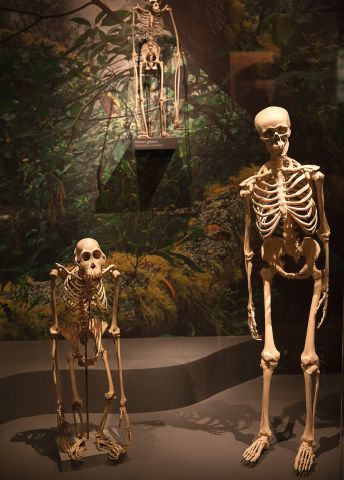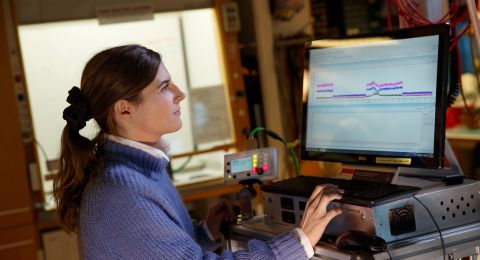
Project Grant 2015
Evolutionary Transitions in Humans – From Nature to Culture
Principal investigator:
Magnus Enquist, Professor of Ethology
Co-investigators:
Stockholm University
Kerstin Lidén
Kimmo Eriksson
Johan Lind
Gunilla Eriksson
University of St Andrews
Daniel Cownden
Harvard Medical School
Pontus Skoglund
Brooklyn College
Stefano Ghirlanda
Institution:
Stockholm University
Grant inSEK:
SEK 22 million over five years
Professor Magnus Enquist looks around at an exhibition on the origin of humankind at the Museum of Natural History in Stockholm. He fixes his gaze on photographs from the Lascaux Caves in France. The cave paintings of prehistoric oxen, wild horses and deer were made between 17,000 and 15,000 years B.C., and are among the oldest works of art in the world.
“Look at the lion’s nose,” he says. “Whoever painted that had the same artistic abilities as modern-day humans.”
The human being – a unique animal
Professor Enquist has only a short walk back to his place of work at the Centre for the Study of Cultural Evolution at Stockholm University, which he heads. The center was founded in 2007 to study the factors shaping and changing human culture.
“The human being is a unique animal. This is reflected in our mental abilities, such as language and thought,” Enquist says.
His research team has been awarded a grant by the Knut and Alice Wallenberg Foundation to examine what it was that caused the evolutionary paths of humans and chimpanzees to diverge some six or seven million years ago. The project is an interdisciplinary one. The researchers represent highly diverse specialist fields at four higher education institutions in Sweden, the U.K. and the U.S.
He himself is an ethologist – a specialist in animal behavior.
“There is a big difference between chimpanzees and humans, but it is not easy to understand how it occurred,” he comments.
The first step will be to identify and describe various learning mechanisms using mathematical models and data simulations. This will be followed by analyses of how these characteristics influence the spread of information between individuals.
“We will be combining the latest research in the fields of AI (artificial intelligence), learning theory and cultural evolution with the latest findings in Paleolithic archaeology and human genetics to find out what it is that makes the human being unique.” Professor Enquist explains.
Animals cannot remember sequences
Much of the work will involve “metastudies” of findings from studies already carried out, mostly by other researchers.
One sub-project has already been completed. It confirms that animals lack the ability to remember sequences of sound and light. About one hundred studies of 13 bird and mammal species show that they are unable to distinguish a red-green sequence from a green-red one. The experiments were repeated thousands of times, but the animals could not learn to see any difference. For humans it is easy.
“Sequences are a feature of many human thought processes. When we plan something we create an order. Language is also about order,” Enquist comments.

He explains that animals also find it difficult to distinguish between rising and falling tones. He demonstrates by whistling a few notes, first with rising pitch, then falling. The difference is easy for the human ear to detect.
Cultural evolution
Many people believe that heredity can explain why humans began to evolve differently from other mammals. But Professor Enquist points out that genetic changes occur very gradually, whereas the leap from animal to human occurred relatively quickly. He believes the explanation lies in cultural development. And by “culture” the researchers here mean implements such as axes and other tools, as well as more abstract constructions such as values or outlook on life.
“We want to examine how organisms learn things they can then pass down from one generation to another. We also want to understand how biological evolution and cultural change continue to affect the way people acquire and disseminate knowledge,” Professor Enquist explains.
Why is it only humans who undergo this transition? Strangely enough, one of the reasons may be that human children are helpless much longer than young animals.
“Taking care of a child is a form of investment. A human child becomes a highly capable organism once it has absorbed all the information available to it,” he points out.

Tools made by thinkers
The next task facing the researchers will be to examine the first stone tools, which began to be used about three million years ago.
“The ability to make simple tools was an advantage for a thinking organism. We will be trying to describe the intellectual functions and the behavior needed to use them. It is fairly easy to make tools out of flint. A single blow is all it takes to get a sharp edge,” Enquist explains.
Chimpanzees also use tools, for example when searching for food. They are able to remove leaves and twigs from the branches of trees, and coax termites out of their nests.
“They do make tools, but on a very limited scale,” Professor Enquist comments.
Text Carin Mannberg-Zackari
Translation Maxwell Arding
Photo Magnus Bergström


